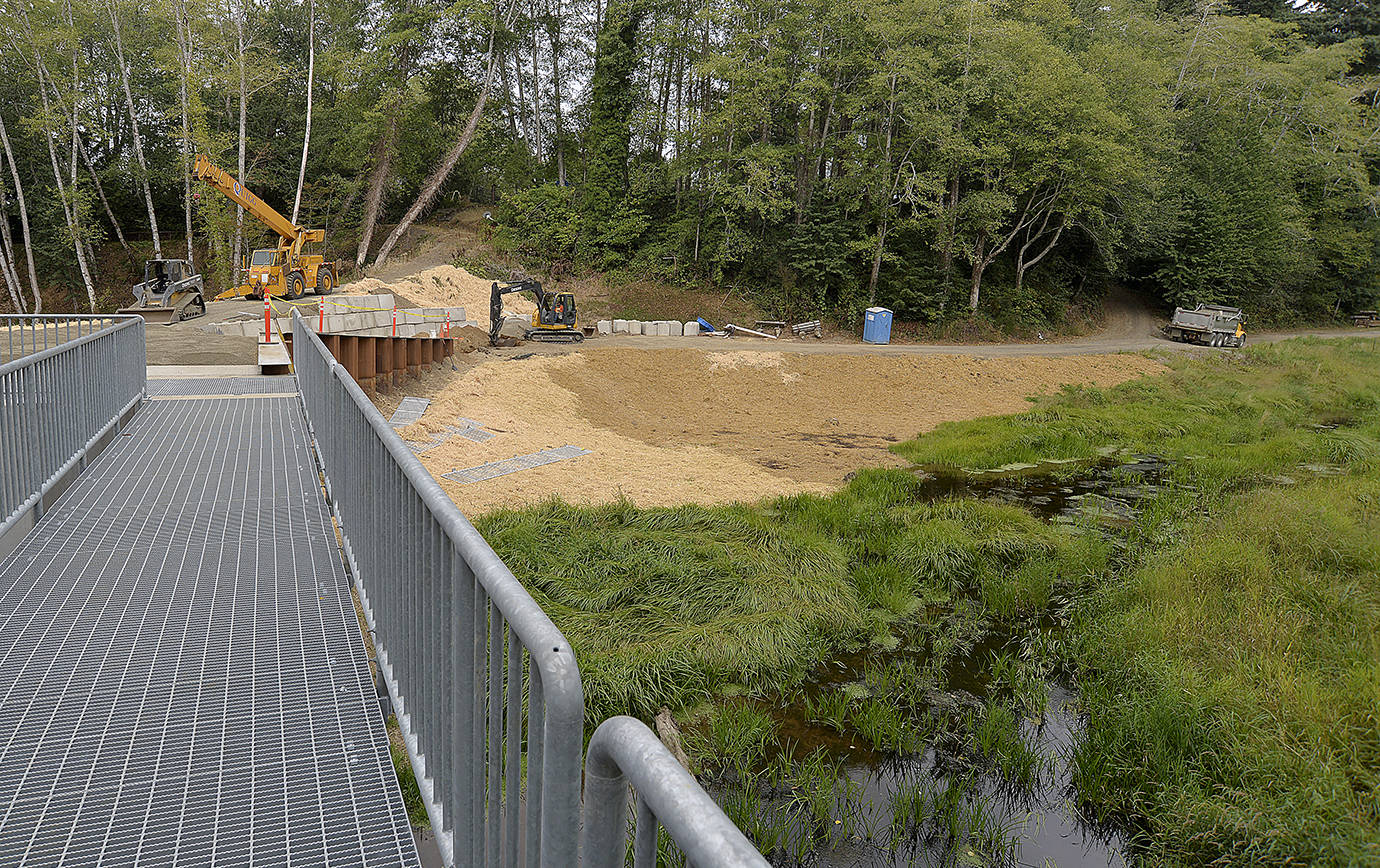Ten years after the dam at Mill Creek Park in Cosmopolis breached, causing flooding that ruined much of the park, a new dam is finished and the park is nearly ready for a grand reopening. The city is itching to show off a new modern concrete, steel and earth dam complete with a fish ladder, viewing platform and fish weirs for migrating salmon and steelhead.
“This is the biggest little project I’ve seen in a long time,” said Cosmopolis Mayor Frank Chestnut from atop the walkway over Mill Creek last week. He said the city is shooting for a Sept. 22, “noonish” dedication for the greatly upgraded dam and park.
History
The first dam on Mill Creek was built around 1913. Chestnut said it was the work of Neil Cooney, a lumber tycoon who needed the water to operate his mill at the Grays Harbor Commercial Company.
The dam was updated in 1970. The mostly earthen dam afforded some flood relief for the homes that line the creek through Cosmopolis, and Chestnut said “somebody thought it would be a good place to build a park.” The pond created by the dam was stocked with fish for kids age 14 and younger, thanks to contributions from the state Department of Fish and Wildlife, the city, private donors and others, said Chestnut, whose own two children were among the park’s many frequent users.
“It wasn’t unusual to come to the park during the evening and have 10 of your neighbors walk by,” said Chestnut, speaking of the popularity of the park.
The breach
The dam held strong for close to 40 years until the torrential rains of November 2008, which undercut a large alder tree that sat above the dam; when it came down it took a chunk of the dam with it. The resulting flood wiped out the park and the walkway over the creek, emptied the pond and caused significant flooding throughout Cosmopolis.
Construction of new dam
After a lengthy search for funding, in 2013 the city received money for pre-construction work and studies. In 2015, the project began, thanks to a grant for architectural and engineering work and dam construction to the tune of a little more than $3 million from the Chehalis Basin Flood Authority and the state Recreation and Conservation Office.
The city got several bids, according to Chestnut and City Administrator Darrin Raines, with Quigg Brothers Inc. emerging as the winning bidder. Construction began in July of 2017.
The new dam is solidly constructed, city officials said; “It’s apples and oranges compared to the old dam,” said Chestnut. Raines added that while on a smaller scale, the same level of science went into the Mill Creek dam’s construction as would go into a Grand Coulee-type structure.
The dam is secured by steel base supports drilled a full 30 feet into bedrock every 18 inches. The primary structure is a 3-foot-thick concrete wall, with a combination of concrete blocks – many recycled from the old dam and the efforts to patch it after the breach — and earth. The sheet pile — sections of interlocking material to help with water-tightness — is anchored 40, and at places, 60 feet down. Any seepage, which would seem unlikely, would be channeled through sand to a drain.
Chestnut is confident this dam will stand the test of time.
“Tell you what, if ‘the big one’ hits, we need to be standing right here,” he said from atop the structure.
Another new addition is the fish ladder, v-shaped concrete lines right below the dam to aid with fish passage. The design of the new dam and its fish ladder has also opened up an additional four miles of accessible fish habitat. Last October, contractors working on the ladder spotted a couple of coho salmon, and later chum salmon returned, said Chestnut.
The base of the dam features flood control gates. They are operated manually and monitored to tell crews when they need to be open, closed and for how long and at what times, depending on conditions. There’s a learning curve in operating the gates.
“There’s an engineered plan what elevation the pond should be,” said Raines. “And when to open and close the gates, and how fast to open and close them. We have a new toy, now we have to learn how to make it work.”
Soon the dam will be ready to hold back the stream and fill the pond behind it, which will take four or five days, said Raines. Then crews will “exercise” the gates, making sure they are functioning properly, and checking to make sure all the components of the dam are structurally sound and water tight.
Chestnut expects the dam to be fully functional within a few weeks. Crews last week were still working on the earthen portion of the dam, securing the metal walkway over the dam and installing safety rails across the top of the dam itself.
The park
Throughout construction, crews have been working on other aspects of the park, including a gravel walkway to the top of the structure, which the city is making sure is as ADA compliant as possible. The trail around the pond has also been graveled, but because of a lack of rain, as of last week, crews had been unable to pack it properly.
There is still a covered picnic area in the park below the dam. However, the old picnic tables were wiped out by the flood and last week a pile of what’s left of them were next to the covered area. Tree roots have done a number on the paved path leading toward the dam and will likely be removed and graveled.
Funding doesn’t cover items outside the dam itself. Raines has been busy recently to figure out the type of lights that would be best to line the trail.


